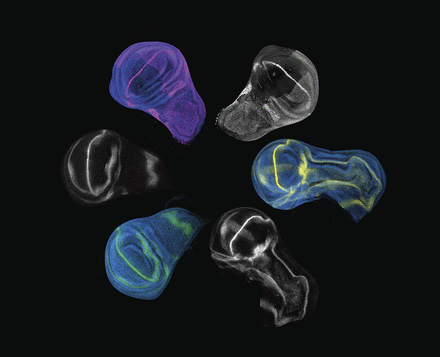The October issue of GENETICS is out now! Check out the Highlights below or the full Table of Contents here.
ISSUE HIGHLIGHTS
A coalescent model for a sweep of a unique standing variant, pp. 707-725
Jeremy J. Berg and Graham Coop
Loci that have recently been under natural selection are commonly identified through the use of genetic polymorphism data. The hitchhiking signature of a selective sweep depends on a number of contingent details of the locus in question, and sweep finding methods would benefit from taking these into account. In this article Berg and Coop offer an explicit coalescent model for the signature of adaptation from a single unique derived variant. They also include a brief simulation study to guide future efforts at identifying such loci.
Preferential breakpoints in the recovery of broken dicentric chromosomes in Drosophila melanogaster, pp. 563-572
Hunter Hill and Kent G.Golic
Calvin Bridges first reported “weak” sites in polytene chromosomes of Drosophila melanogaster 80 years ago. In the late 1980’s Charles Laird and colleagues proposed that these weak sites, by that time known as intercalary heterochromatin, provide a model for fragile sites in human mitotic chromosomes. The results reported in this article support that connection, showing that sites of dicentric chromosome breakage in mitosis are clustered at or near the regions of chromosomes that, in salivary glands, form intercalary heterochromatin.
Prediction of plant height in Arabidopsis thaliana using DNA methylation data, pp. 779-793
Yaodong Hu, Gota Morota, Guilherme J. M. Rosa, and Daniel Gianola
These investigators used DNA methylation information to predict plant height in a population of isogenic Arabidopsis thaliana lines differing in epigenetic profiles. They estimated that epigenetic variation accounted for 65% of the phenotypic variance. Their results suggest that DNA methylation information can be useful in whole-genome prediction of complex traits, offering a high potential for trait prediction using a combination of genomic and epigenomic data.
Choosing subsamples for sequencing studies by minimizing the average distance to the closest leaf, pp. 499-511
Jonathan T. L. Kang, Peng Zhang, Sebastian Zöllner, and Noah A. Rosenberg
Geneticists routinely prioritize individuals, strains, or populations for genotyping or DNA sequencing. Techniques based on phylogenetic principles can assist in these experimental design decisions, and Kang et al. investigate a new phylogenetically-derived method for selecting samples for sequencing: minimizing the average distance to the closest leaf (ADCL). Employing both simulated data and 1000 Genomes sequences, they show that their new algorithm provides a significant improvement to imputation accuracy over an earlier algorithm.
Genotype-frequency estimation from high-throughput sequencing data, pp. 473-486
Takahiro Maruki and Michael Lynch
This article presents a maximum-likelihood method for estimating allele and genotype frequencies from high-throughput sequencing data. The method makes no assumptions about a mating system or internal structure of the population, and factors out potential biases from sequencing errors and binomial parental chromosome sampling. Performance evaluations with computer simulations and low-coverage sequencing data from a human population show that the method yields nearly unbiased estimates with minimum sampling variance, even with moderate depths of coverage.
Genetic control of environmental variation of two quantitative traits of Drosophila melanogaster revealed by whole-genome sequencing, pp. 487-497
Peter Sørensen, Gustavo de los Campos, Fabio Morgante, Trudy F. C. Mackay, and Daniel Sorensen
The mechanisms responsible for environmental variability of traits is relevant in medicine and agriculture. These investigators studied genetic control of environmental variance of two traits in fully sequenced inbred lines ofDrosophila: starvation resistance and startle response. They show how genome sequence information and modern statistical methods cast light on genetic mechanisms underlying environmental variance. They found sex-specific genomic variance of environmental variance for starvation resistance but not startle response.
Inner kinetochore protein interactions with regional centromeres of fission yeast, pp. 543-561
Jitendra Thakur, Paul B. Talbert, and Steven Henikoff
Centromeres are chromosomal regions on which the kinetochore assembles. Plant and animal centromeres usually span megabases of DNA and are embedded in highly repetitive sequences, making them difficult to analyze. The relative simplicity of fission yeast centromeres makes them a model for studying centromeres. These investigators mapped centromeric nucleosomes and other kinetochore proteins on the fission yeast genome and found that they are not influenced by the underlying DNA sequence, in contrast to repeat-rich regional centromeres, which are characterized by well-positioned centromeric nucleosomes.
Modeling the manipulation of natural populations by the mutagenic chain reaction, pp. 425-431
Robert L. Unckless, Philipp W. Messer, Tim Connallon, and Andrew G. Clark
Engineered genetic elements that can spread through populations by cheating Mendelian segregation have great potential for biological control. There is, however, cause for concern of unintended consequences of these genetic drive systems. This article describes a model of the spread of an allele through the mutagenic chain reaction. The authors describe several different outcomes depending on parameters assumed. However, under many circumstances, the timeframe to fixation of an allele is very fast.































